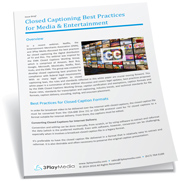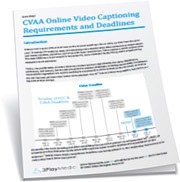Closed Caption Frame Rates for Digital TV and Film
Updated: March 25, 2021
In April, we held a webinar with Netflix and the Entertainment Merchants Association on the closed captioning best practices for the digital distribution of TV and film. Sean Bersell, the VP of Public Affairs at the Entertainment Merchants Association, discussed (among other things) the best practices for caption frame rates and how to convey this information for caption files (such as video frame rate conversion). These best practices were proposed by the EMA Closed Captions Working Group–consisting of Amazon, Best Buy, Google, Microsoft, MovieLabs, Netflix, Rovi, Vudu, and the EMA–which was created to develop closed captioning best practices for federal legal compliance.
The Issue with Online Video + Conversion
The main issue is that ideally, the caption (or subtitle) frame rate should match the native frame rate of the source video. However, oftentimes this is not the case, and the synchronization of the two can be a problem. The main problem here is that the frame rate requirements for broadcast TV do not match the frame rate requirements for Internet video, which usually requires conversion of the video’s frame rate in the caption file when the video is transitioned from television to the Internet. Some video distributors require that the captions and video be synched when the file is delivered to them; others will take unsynched caption files.
Best Practices for Closed Captioning and Subtitle
For those distributors who will take unsynchronized caption (or subtitle) files, the best practices are for the closed caption file to be submitted in any frame rate in which it was created, so long as it is clearly indicated. For SCC files, the file name should indicate whether the file is drop-frame (DF) or non-drop-frame (NDF), as the protocol for the time code depends upon this differentiation. DF files use a semicolon between seconds and frames (hours:minutes:seconds;frames) while NDF files use all colons (hours:minutes:seconds:frames).
Caption or Subtitle Frame Rate Conversion
If the video distributors require the file to be synched when delivered, you must convert your caption or subtitle frame rate so it is synchronized with the video ahead of time.
We encourage you to read the white paper to learn further best practices, standards, and legal requirements for closed captioning.
Further Reading

Subscribe to the Blog Digest
Sign up to receive our blog digest and other information on this topic. You can unsubscribe anytime.
By subscribing you agree to our privacy policy.







